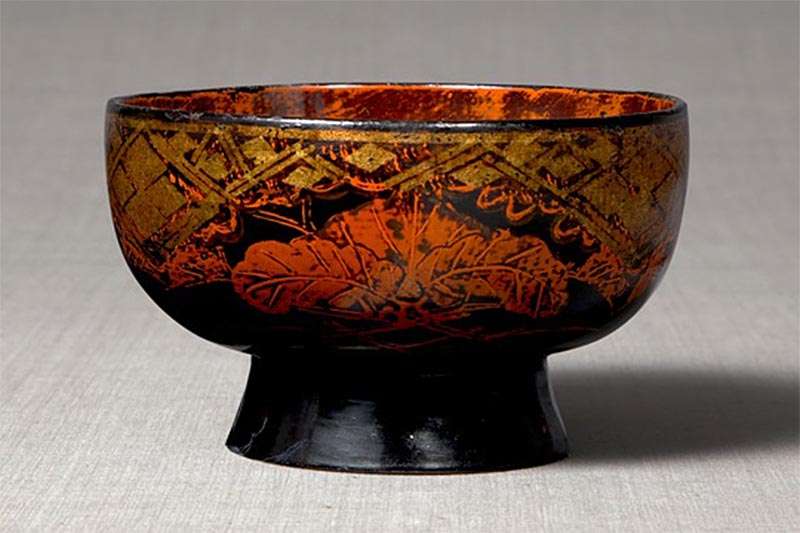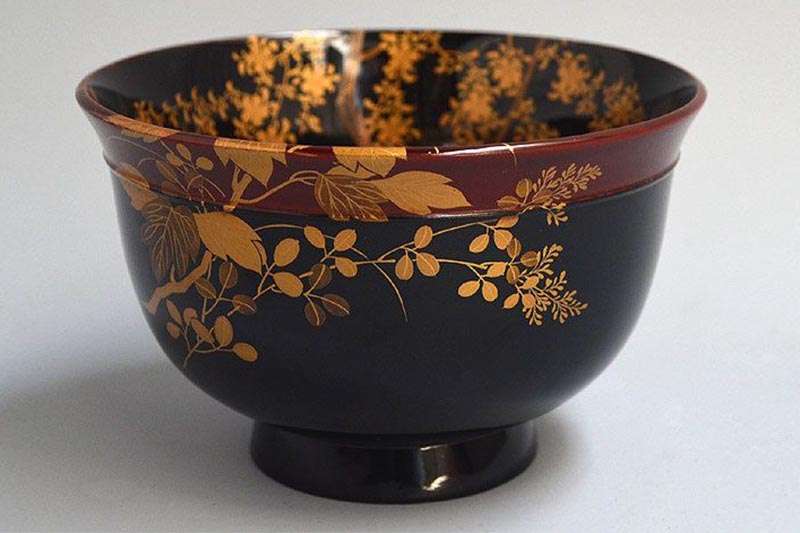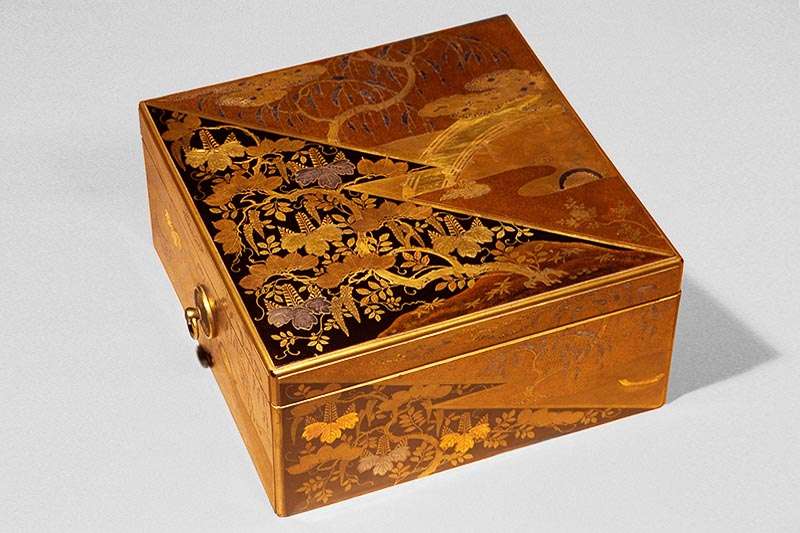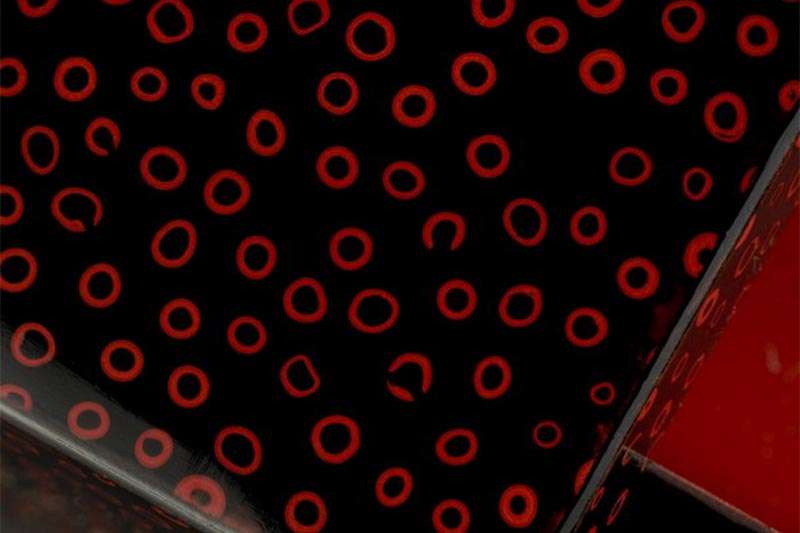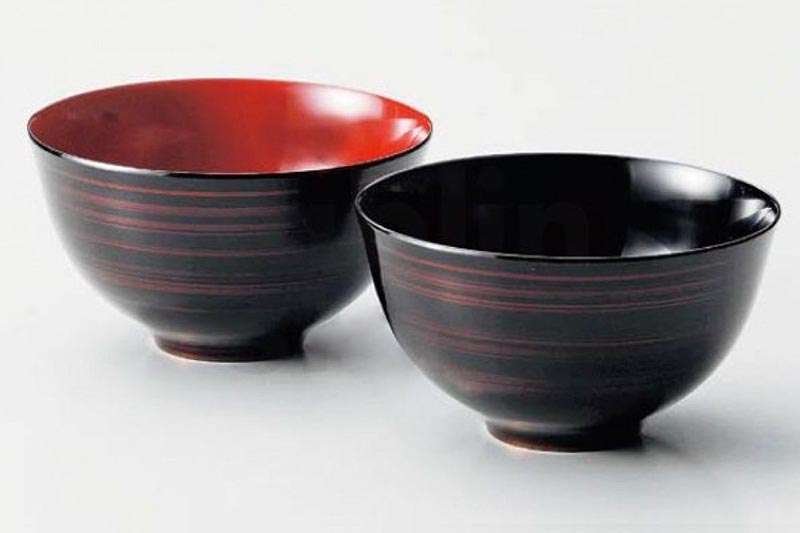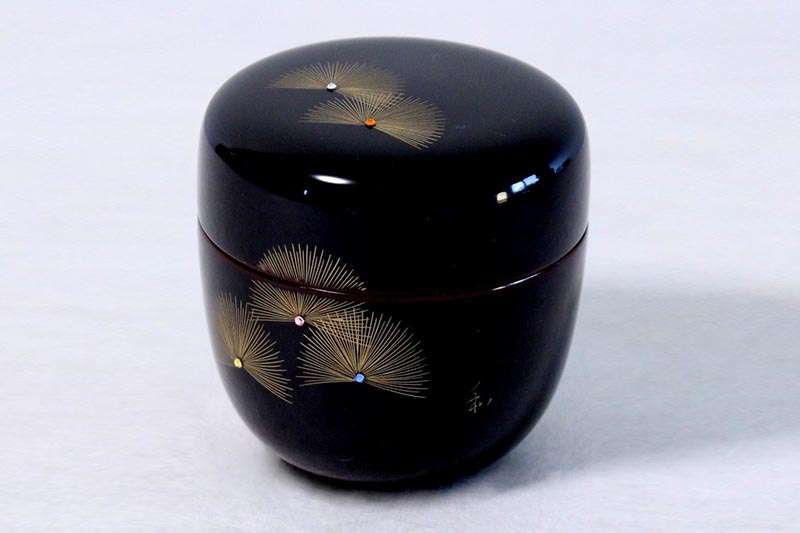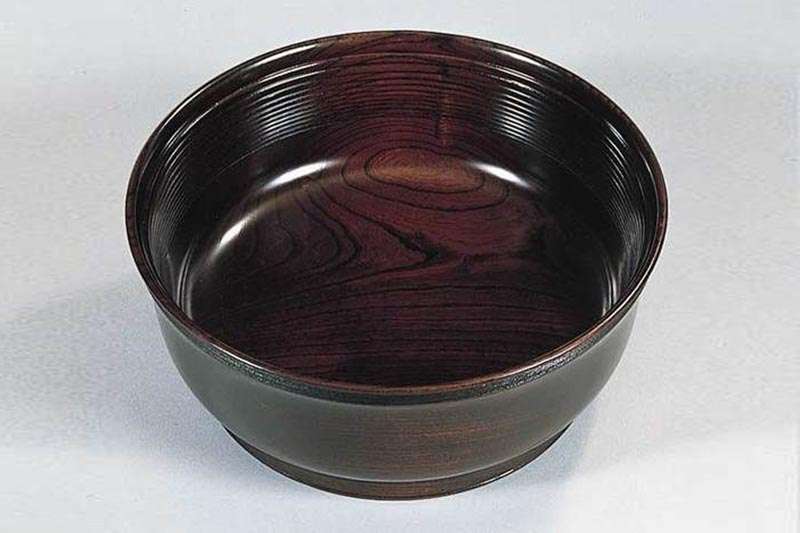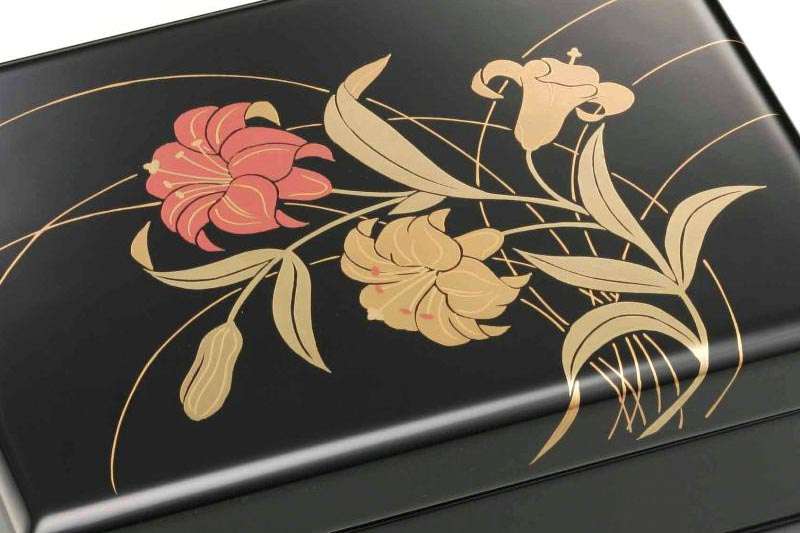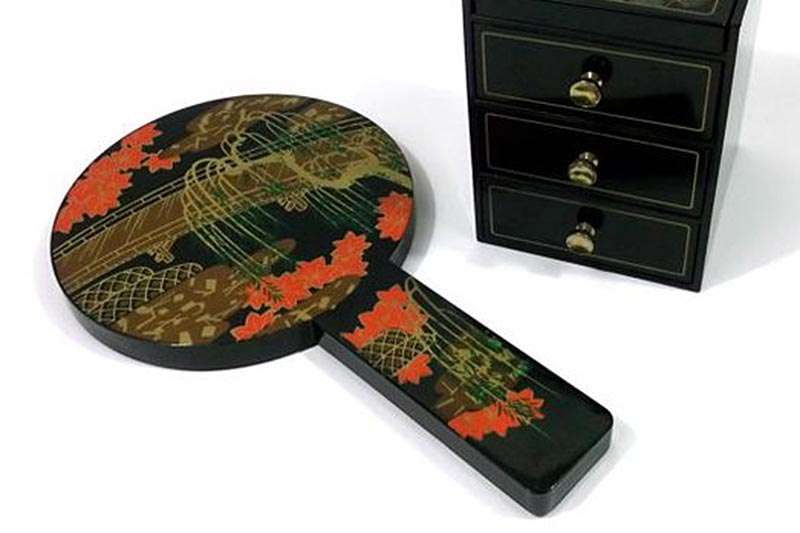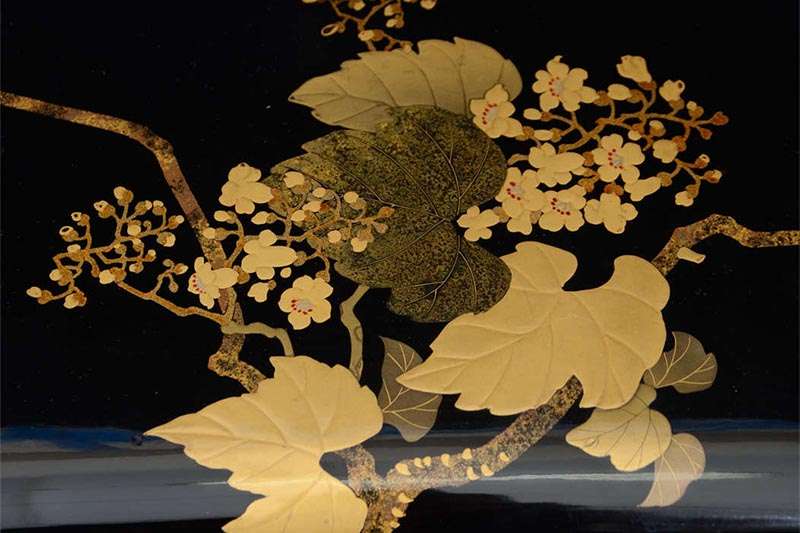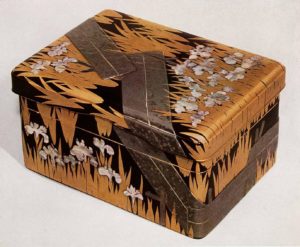Lacquer-ware
the cat naps
in a lacquered tray…
summer room
–Issa
The deep, shiny luster of black or dark red lacquerware, often gorgeously decorated with gold and silver or inlaid with mother-of-pearl, is a Japanese handicraft form that has long fascinated the world. No other application style can match the deep hues and smoothness of Japanese lacquer (urushi in Japanese). Lacquerware stands as one of the most distinctive forms of Japanese beauty.
Urushi is the sap of the urushi or lacquer tree that is native to Japan, China, and Korea. The sap of this tree contains a resin that polymerizes and becomes a very hard, durable, plastic-like substance when it is exposed to moisture and air.
Contemporary historical research indicates that the knowledge of urushi lacquer technology was introduced from China to Korea, and from there to Japan. Though Japan had also been using lacquer in ancient times, the systematic application process used in Japanese lacquerware is said to have developed in China. However, the discovery of Japanese lacquerware in Japan from the Jomon period (ca 10500-ca 300 BC) offers strong evidence that lacquer technology also independently developed in Japan.
Stone-age people first discovered the useful properties of the urushi tree and took advantage of its adhesive properties to mount points on spears and arrows. The Japanese of the Jomon period recognized the durability and shiny beauty of urushi and began using it to coat wood, pottery, baskets and bone objects. The arrival of Buddhism in Japan made lacquer production a key industry as it was used together with cloth to create Buddhist images.
From that time onward, as Japanese culture developed, so did its use of lacquer and its application to bowls, plates, trays, saké cups, boxes, combs and other objects. As Japanese civilization developed, lacquerware techniques continuously incorporated ever more refined styles. The Nara period (710-794) saw the birth of the maki-e decoration technique in which gold “dust” was decoratively sprinkled on the lacquer surface.
Urushi has found many uses in Japanese craft and culture forms. Urushi bowls or plates are an essential part of Japanese haute cuisine forms such as kaiseki. Maki-e (sprinkled application of gold or silver powder) and raden (mother-of-pearl inlay) urushi techniques have been widely used to elegantly decorate furniture, make-up accessories, toys, and writing implements.
Due to the traditional knowledge possessed by the many skillful craftsmen centered around the imperial court, Kyoto prospered as the center of Japan’s lacquer ware industry from the Muromachi period (1333-1568) onwards. Kyoto lacquerware has always been regarded as the most exquisite in all of Japan.
The era, known as ”Higashiyama Maki-e,” brilliantly reflects the splendor of the Kyoto lacquerware, which exquisitely expressed the subtle aesthetic ideas of wabi (rustic simplicity, freshness or quietness) and sabi (patina or the beauty or serenity that comes with age) that are so important in the Japanese tea ceremony.
In the Azuchi Momoyama Period (1573-614), Kyoto lacquer ware strongly reflected the tastes and preferences of the affluent and dominant warrior class. The gorgeous rich effects of Kodaiji Maki-e are particularly noteworthy. Beginning in the Edo Period (1600-1868), despite the popularity for brilliance and glitter, works started to reveal increasingly delicate and elaborate aesthetic preferences.
Today, Kyoto lacquerware is not limited to only ornamental objects, but also includes ordinary tableware, furniture, as well as a number of different household effects. Kyoto lacquerware has been designated as a ”Traditional Japanese Handicraft Form” by the National Government.
Zohiko
Producing quality lacquer since 1661
Zohiko is one of Kyoto’s most exclusive Kyoto lacquer shops. It is presently located near Heian Shrine. Originally, it was located on Teramachi when the first generation owner opened a shop named Zoge-ya (literally Ivory Shop) which offered goods and tools imported from China.
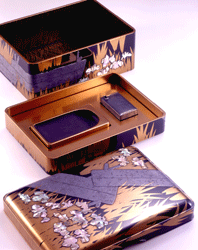 In the early Edo period (1600-1868), the third generation owner and lacquer craftsman, Hikobe Nishimura, created an incredibly beautiful lacquer art and maki-e decoration of a sacred white elephant and the Fugen Bosatsu (Buddhist deity). He donated it to the family temple and it became famous throughout the city. From that time onwards, people started to call the work of the studio “Zohiko“: Zo for elephant and Hiko for Hikobe.
In the early Edo period (1600-1868), the third generation owner and lacquer craftsman, Hikobe Nishimura, created an incredibly beautiful lacquer art and maki-e decoration of a sacred white elephant and the Fugen Bosatsu (Buddhist deity). He donated it to the family temple and it became famous throughout the city. From that time onwards, people started to call the work of the studio “Zohiko“: Zo for elephant and Hiko for Hikobe.
The original of this gorgeous ink stone box (a National Treasure) was created by Korin Ogata (1658-1716), one of the artistic geniuses of the Edo period. The maki-e decoration shows one of the scenes from the Ise Monogatari (a long Heian period poem). Zohiko is active in the preservation of urushi culture.
Since that time, Zohiko has been a top quality Kyoto lacquerware production studio. The present generation owner, the 9th Hikobe Nishimura, has also tried to adapt the traditional beauty of lacquer to modern times. For example, he collaborated with a Swiss watch manufacturer to create special wrist watches (limited production) a few years ago.
Zohiko is also highly active in the preservation of Japanese culture. On the second floor of their main shop, there is a small museum devoted to exquisite lacquer work, Kyoto dolls, folding fans, ceramics, glass ware, Noh theatre masks, metal crafts, woodblock prints, and other craft forms. Entry to the gallery is free of charge.
Interview with Mr. Okura
“I never feel bored with my work. There is always something new to learn.”
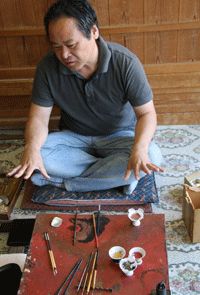 Mr. Okura in his studio. The chest-like furniture behind him is a muro, used to dry lacquerware. Lacquer will not harden if the humidity is not high enough. The inside of the muro maintains an 80% of humidity level at 25 degrees centigrade.
Mr. Okura in his studio. The chest-like furniture behind him is a muro, used to dry lacquerware. Lacquer will not harden if the humidity is not high enough. The inside of the muro maintains an 80% of humidity level at 25 degrees centigrade.
Mr. Okura has been working as a maki-e and gold foil decoration craft master at Zohiko for nearly 28 years. His career as a maki-e craftsman started when he finished university. ”My father was also a maki-e craftsman and as I loved to create things with my hands, I had no doubt that I would be a maki-e craftsman just like my father was.” In his small studio, he sits alone and concentrates on finishing each piece painstakingly by hand. He completes only a few works a day. Some objects take more than one month to finish.
The production process for making lacquerware can be roughly divided into three parts: making the wooden base, lacquering, and maki-e decoration. For exceptionally high quality works, over 50 separate production steps must be completed, of which 20 involve the application of lacquer. Each lacquering stage has a different name but they are all directed to one goal: getting the final surface to be as hard as possible. The more layers of urushi applied, the harder the surface becomes.
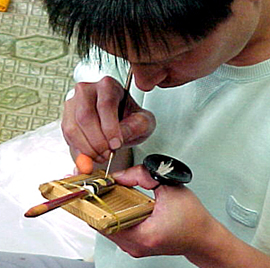
Maki-e artist brushing yellow tinted urushi on top of the stanciled design. Notice the special pallet (tsume ban) attached to his thumb.
The best brush for drawing on lacquerware is made of the underarm hair of rats. The hair is really thin and has the perfect hardness. The square tool Okura wears on his thumb is called a Tsume-ban which as a lacquer palette. The inside of the shell doesn’t absorb lacquer. The one on the right is Okura’s original Tsume-ban which he has been using for many years.
Okura explains, “Typical woods used for lacquerware are zelkova, horse chestnut and cherry tree as they are very strong to begin with. The most defining characteristic of Kyoto style lacquerware is its unbelievable thinness.” Using a lathe and a plane, the wood is made as thin as possible. In fact, the final wood base is so thin that you can see the light through the grain. This thinness is the key to the amazing light and delicate feel of Kyoto lacquerware. And yet it is very strong.
“My work requires exceptional concentration. I need to create exactly the same design by hand. I don’t decide what to draw. All I do is copy. And yet I never feel bored with my work. There is always something new to learn.” Okura does worry that the demand for quality lacquer ware is decreasing. Despite the passion and excellence of the craftsman the industry can not survive without sufficient demand.
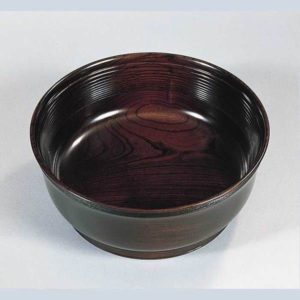 Incredibly thin wooden bowl (made of Japanese keyaki or zelkova). Light goes through it.
Incredibly thin wooden bowl (made of Japanese keyaki or zelkova). Light goes through it.
“I think urushi is one of Japan’s finest and most representative craft forms. It is characterized by precision craftwork and expresses the elegant beauty of Japan. I hope foreign visitors will find the essence of Japan in our urushi crafts and arts. I believe, that once they touch and hold a piece of top quality lacquer they will be amazed at how light and beautiful it is.” Okura speaks slowly and does not use a lot of extra words but there is certain persistence and passion in his speech that echoes his work.
There are pieces here ranging in price from reasonable to astronomical, and the best part of it all is the private museum on the second floor, which is opened to any serious patron. This is where fans of lacquerware come to dream.
Buying Japanese Lacquerware
Kiyomizu Sannenzaka Museum
At this museum in Kyoto, there is a collection of lacquerware objects made with techniques that are no longer possible today, and a detailed description of the different methods for creating maki-e designs, both in poster form and on video tape.
Though the museum is small (enough to fully appreciate within an hour) it regularly hosts special exhibitions of rare and beautiful lacquerware along with its permanent collection, and there is a gift shop where lacquered objects can be had at reasonable prices.
The Gallery of Kyoto Traditional Arts and Crafts displays creatively designed, as well as more traditional, lacquerware produced by local artisans. You can also watch students creating new works in one of the museum’s galleries. Several shops in Kyoto, including some that make lacquerware, cooperate with the museum by giving guests an introductory experience in their craft. Visit the Gallery of Kyoto Traditional Arts and Crafts website to make a reservation
http://www.kyotohandicraftcenter.com/shop_guide/detail.html?lang=en&id=36
How to Care
To properly maintain lacquerware take the following precautions.
- Do not soak in hot or cold water for a long time. Wash with warm water and dry with a soft cloth.
- To maintain a good gloss, wipe gently with a soft cloth after washing. Avoid excessive force.
- Avoid putting in the refrigerator, the dishwasher, under direct sunshine, or in extremely dry places. This could lead to discoloration.
- Do not use with direct heat, in a microwave, or in an oven.
Note: In rare cases, some people may experience an allergic reaction to lacquer. In such cases, please consult a doctor.





